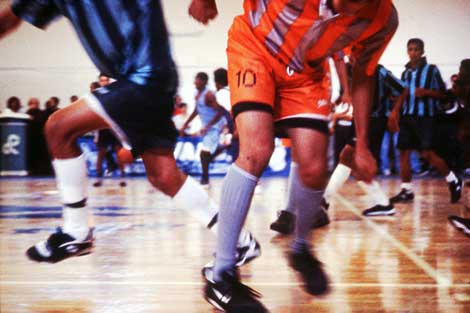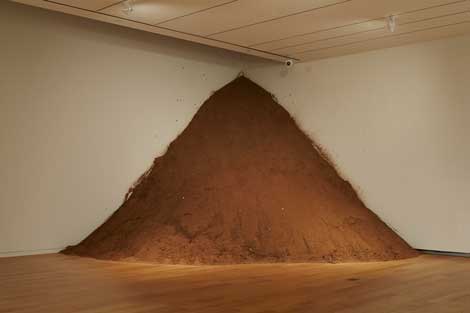Surveying advanced art from Mexico City during the last quarter century, “México Inside Out: Themes in Art Since 1990” includes the work of 22 artists, mostly in their 30s and 40s, and one collective. The fact that several artists are not native Mexicans demonstrates the newly won art-world status of Mexico City, where most of them live and work. Now-familiar mediums of video and installation art make up the bulk of the show, which resembles the typical international survey today. Easel painting was noticeably absent, but a few contributions, such as Minerva Cuevas’s America, a wall painting of a comic Donald Duck wallowing in a heap of gold coins, allude to Mexico’s post-revolutionary mural tradition. Many works recall the politics of Rivera and Siqueiros, filtered through contemporary narratives of identity, otherness and power, driven first by multiculturalism in the United States, then by globalization worldwide.
Visually, the individual works are strikingly handsome and exquisitely crafted. Generously installed with the guidance of curator Andrea Karnes, along with assistant curator Alison Hearst, the Modern Art Museum of Fort Worth has provided ample space to articulate their messages with drama and clarity.
Overall, the exhibition’s thrust is didactic, reinforced by Karnes’s thorough, interpretative essay in the accompanying catalog. Several predictable Mexican narratives emerge: death, drugs, and machismo, in particular. While there are no skeletons or skulls, the mysterious tragedy of the maquiladoras is the subject of Artemio’s Untitled (Portrait of 450 Murdered Women in Ciudad Juárez) from 2009, with 27,000 kilos of dirt from the Juárez desert piled high in a corner of a gallery, and José Jiménez Ortiz’s Eternity is Possible (2011), documenting the artist’s company, Vivireternamente, which manages the social network accounts and “afterlife identities” of recently deceased youths. Death is closely linked to the violent drug wars in Mexico, a subject memorialized in all of Teresa Margolles’s work. Shot Wall (Culiacán), 2009, is a 13-foot-long cinder block wall, transported from the streets of Culiacán to the museum. As the background to a deadly gunfight between police and drug traffickers, Shot Wall is punctured by scores of bullet holes, each ominously numbered by an investigator’s pencil. In bloody pictures and blaring headlines, Margolles’s PM 2010 (2012) includes a year’s worth of individually framed front pages of the tabloid PM, which features a daily drug-war victim. In Yoshua Okón’s videos, the ironic demystification of authoritarian masculinity is at once horrifying and comedic. Octopus was filmed in the parking lot of a Los Angeles Home Depot in 2011. Guatemalan day laborers, who fought on opposite sides of the civil war in their home country, were engaged to reenact their battles by running, hiding and riding on Home Depot carts while shooting imaginary rifles. Okón’s video projection, Orillese a la Orilla (1999-2000), depicts aggressive policemen, invited to the artist’s studio for the project, arguing with the unseen artist/videographer or violently wielding a steel baton like a fighting stick.
The subject of competitive sports was another common thread. Gabriel Orozco’s Ping Pong Table (1998) consists of two green ping pong tables with rounded edges conjoined in a clover-like formation. At the intersection is a square blue pool with floating water lilies. When four players compete, the ball must clear the pond that separates and links them, alluding to geopolitical competition between nations on the ocean-strewn globe. Orozco also contributed the Atomists, a series of computer-generated photographic prints of soccer players, overlaid with dual-colored disks and ellipses. Formally, the abstract shapes create a geometric foil for the anthropomorphic gestures of the athletes and echo the soccer ball, while concealing and flattening photographic information. Gustavo Artigas’s Rules of the Game (2000) is a compelling 11-minute video shot on a high-school basketball court. While two basketball teams from San Diego compete, two soccer teams from Tijuana play each other on the same court at the same time. Masses of moving bodies, miraculously avoiding serious collisions, fill the screen until the conclusion, when each smiling team member receives a trophy.
The videos of Belgian artist Francis Alÿs and British-born Melanie Smith, both collaborations with filmmaker Raphael Ortega, take a longer, historicized perspective on the spirit of Mexico. Alÿs’s Rehearsal 1 (1999-2000) opens with a long shot of a dusty road up a steep hill culminating with a few modest houses and a wandering dog. Recorded by a stationary camera, a bright red Volkswagen Beetle attempts to climb the hill while the sound of a brass band’s raucous rehearsal is heard. Each time the band encounters difficulties and breaks off, the VW rolls back down the hill from its partial ascent. When the band starts up, the car begins its Sisyphean climb anew. At the end of the half-hour video, the repeated attempts prove ultimately futile. Evocative of Mexico’s struggle for modernization—given the weight and endurance of its pre-Conquest past—Rehearsal 1 accomplishes on a comparably homely scale what Melanie Smith’s Aztec Stadium: Malleable Deeds (2010) achieves in an expansive, spectacular manner. Enacted by 3,000 public school students in Mexico City’s largest stadium, the scenario progresses from a tightly ordered choreography of the whole to individually fueled rebelliousness and distraction, echoed by the soundtrack of an electric guitar solo beginning with a Mexican march and ending with reverberating improvisation. On cue, students hold aloft printed placards that form monumental mosaics of familiar images. On the field, students create Malevich’s utopian abstract painting of a red square; in the bleachers, images on the placards range from a popular masked wrestler to a fourteenth-century mask of the god Xipetotec. Eventually, the students begin to quarrel, drop their cards and wander from the stands.
Thomas Glassford’s gallery-filling installation, Untitled Collection (2013), was drawn from his enormous collections of used broomsticks (bought for a peso apiece from junk scavengers) and melamine dishware. Grouped by color, thousands of painted broom handles are packed upright into library-style metal bookshelves; four of the three-tiered shelves ran the length of the gallery. Their bright colors—red, blue, green, yellow and an unpainted few—are worn, chipped, even written upon. Unsystematically alternated and repeated, the colored clusters of sticks create an undulating sweep of sensuous radiance. Newly painted in cheerful colors, a string of melamine bowls, cups, and saucers—threaded through holes drilled in the bottom of each—hung swag-like from the ceiling. Based on the context of a primarily narrative exhibition, Glassford’s materials conjure the social through association: from status (trash picker, housekeeper) to site (the street, the corner café). His palpable attention to formal issues, however, expanded the breadth of concerns animating this fashionable yet highly intelligent show.




